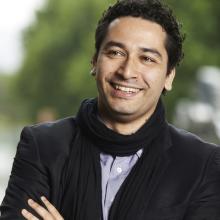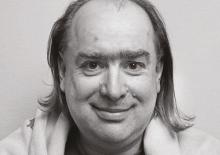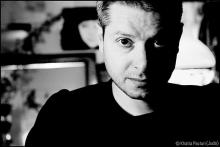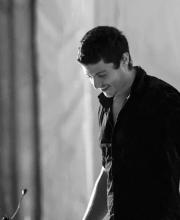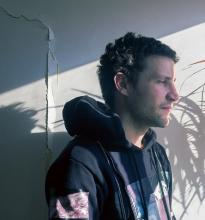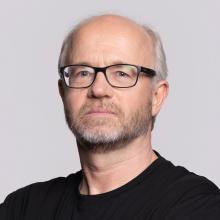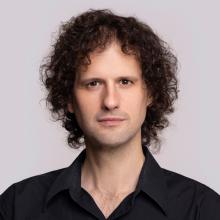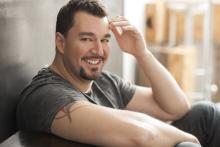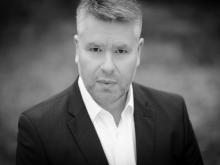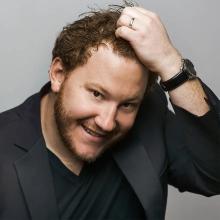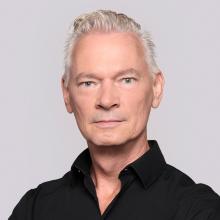Fidelio
Ludwig van Beethoven (1770-1827)
The version chosen for this production of Fidelio is largely based on Gustav Mahler's 1904 version. This means that the Rocco aria is not performed, but the Leonore 3 overture is heard in the finale of the second act. During one of the scene changes, you will also hear a fragment of the Funeral March from Symphony No. 3 (Eroica).
Duration
2 hours and 45 minutes, including one intermission
The performance is sung and spoken in German, with surtitles in Dutch and English.
Libretto
Joseph Sonnleithner
New dialogues by Andriy Zholdak
Musical direction
Andrés Orozco-Estrada
Stage direction and lighting design
Andriy Zholdak
Set design
Andriy Zholdak / Daniel Zholdak
Costumes
Andriy Zholdak / Simon Machabeli
Video design
Etienne Guiol
Associate video design
Malo Lacroix
Dramaturgy
Luc Joosten
Don Fernando
Mark Kurmanbayev
Florestan
Eric Cutler
Rocco
James Creswell
Don Pizarro
Nicholas Brownlee
Leonore
Jacquelyn Wagner
Marzelline
Anna El-Khashem
Jaquino
Linard Vrielink
Erster Gefangener
Stefan Kennedy
Zweiter Gefangener
Peter Arink
Royal Concertgebouw Orchestra
Chorus of Dutch National Opera
Chorus master
Edward Ananian-Cooper
Part of the Holland Festival
Production team
Assistant conductor
Aldert Vermeulen
Assistant directors
Frans Willem de Haas
Maarten van Grootel
Associate lighting designer
Cor van den Brink
Assistant directors during performances
Frans Willem de Haas
Maarten van Grootel
Rehearsal pianists
Nathalie Dang
Ernst Munneke
Language coach
Miriam Kaltenbrunner
Assistant chorus master
Kuo-Jen Mao
Language coach chorus
Cora Schmeiser
Senior stage manager
Joost Schoenmakers
Showcaller
Pieter Loman
Stage managers
Julia van Berkel
Emma Eberlijn
Zoë Pauel (intern)
Artistic planning
Margot Vervliet
Children supervisor
Manon Wittebol
Costume supervisors
Maarten van Mulken
Mariama Lechleitner
Master carpenter
Jop van den Berg
Lighting manager
Coen van der Hoeven
Props master
Peter Paul Oort
First dresser
Jenny Henger
First make-up artist
Isabel Ahn
Sound design
Juan Verdaguer
Sound technicians
Leonardo Santos
Hans van Wegen
Lighting operator
Erik Vrees
Video operator
Joshua Sahanaja
Surtitle director
Eveline Karssen
Surtitle operator
Maxim Paulissen
Head of the music library
Rudolf Weges
Set supervisor
Sieger Kotterer
Production manager
Edgar Lamaker
Chorus of Dutch National Opera
Sopranos
Patricia Atallah
Lisette Bolle
Taylor Burgess
Jeanneke van Buul
Caroline Cartens
Melanie Greve
Marlina Deasy Hartanto
Maaike Hupperetz
Oleksandra Lenyshyn
Simone van Lieshout
Tomoko Makuuchi
Vesna Miletic
Sara Pegoraro
Lise Petrovitch
Sandra Siniväli
Altos
Irmgard von Asmuth
Elsa Barthas
Anneleen Bijnen
Daniëlla Buijck
Rut Codina Palacio
Liza Lozica
Yvonne Kok
Fang Fang Kong
Maria Kowan
Maaike Molenaar
Emma Nelson
Sophia Patsi
Marieke Reuten
Leonie van Rheden
Ruth Willemse
Tenors
Frank Engel
Milan Faas
Cato Fordham
Dimo Georgiev
Erik Janse
Stefan Kennedy
Raimonds Linajs
Tigran Matinyan
Frank Nieuwenkamp
Richard Prada
Mitch Raemaekers
Mirco Schmidt
François Soons
Julien Traniello
Jeroen de Vaal
Rudi de Vries
Basses
Ronald Aijtink
Peter Arink
Jorne van Bergeijk
Nicolas Clemens
Agris Hartmanis
Hans Pieter Herman
Tom Jansen
Geert van der Kaaij
Richard Meijer
Matthijs Mesdag
Maksym Nazarenko
Christiaan Peters
Matthijs Schelvis
Jaap Sletterink
Rob Wanders
Jouke Wijmenga
Extras
Floor Scholten
Martje de Mol
Maurits van der Roest
Bert Mulder
Wil Brandhorst
Jochem van der Zaag
Samuele Ninci
Sofia Garcia Miramon
Children extras
Huub Hennekens
Jonas Kool
Juliëtte Broos
Ruza Haalmeijer
Royal Concertgebouw Orchestra
First violin
Tjeerd Top
Ursula Schoch
Marleen Asberg
Keiko Iwata
Tomoko Kurita
Henriette Luytjes
Borika van den Booren
Junko Naito
Benjamin Peled
Nienke van Rijn
Jelena Ristic
Michael Waterman
Mirelys Morgan Verdecia
Second violin
Alessandro Di Giacomo
Caroline Strumphler
Jaewon Lee
Elise Besemer
Anna de Vey Mestdagh
Leonie Bot
Nadia Ettinger
Corline Groen
Gregor Horsch
Sanne Hunfeld
Sjaan Oomen
Jane Piper
Eke van Spiegel
Joanna Westers
Viola
Michael Gieler
Saeko Oguma
Frederik Boits
Roland Krämer
Guus Jeukendrup
Eva Smit
Yoko Bungeroth
Martina Forni
Vilém Kijonka
Edith van Moergastel
Anna den Herder
Anna Smith
Cello
Tatjana Vassiljeva
Johan van Iersel
Benedikt Enzler
Chris van Balen
Jérôme Fruchart
Christian Hacker
Maartje-Maria den Herder
Boris Nedialkov
Clément Peigné
Honorine Schaeffer
Double bass
Dominic Seldis
Théotime Voisin
Rob Dirksen
Léo Genet
Felix Lashmar
Georgie Poad
Nicky Schwartz
Olivier Thiery
Flute
Kersten McCall
Julie Moulin
Vincent Cortvrint
Oboe
Alexei Ogrintchiouk
Alexander Krimer
Clarinet
Olivier Patey
Davide Lattuada
Bassoon
Gustavo Nunez
Justin Cherry
Simon Van Holen
Horn
Laurens Woudenberg
Jonathan Wegloop
José Sogorb
Jaap van der Vliet
Trumpet
Omar Tomasoni
Hans Alting
Álvaro Garcia Martín
Trombone
Sebastiaan Kemner (5, 9 June) / Jörgen van Rijen (11, 17, 19, 23, 26, 29 June)
Nico Schippers (5, 9, 11, 17 June) / Martin Schippers (19, 23, 26, 29 June)
Raymond Munnecom
Timpani
Tomohiro Ando












